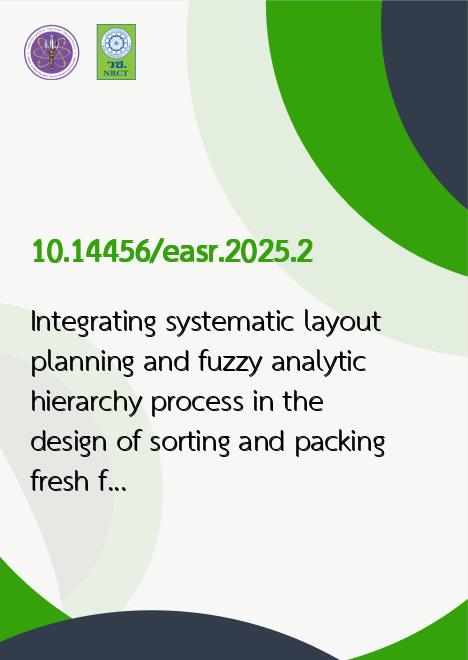
|
Integrating systematic layout planning and fuzzy analytic hierarchy process in the design of sorting and packing fresh fruit facilities: A case study in Thailand |
|---|---|
| รหัสดีโอไอ | |
| Creator | 1. Thanapong Ruamsuke 2. Wichuda Mingsakul 3. Nalinee Chanamool |
| Title | Integrating systematic layout planning and fuzzy analytic hierarchy process in the design of sorting and packing fresh fruit facilities: A case study in Thailand |
| Publisher | Faculty of Engineering, Khon Kaen University |
| Publication Year | 2568 |
| Journal Title | Engineering and Applied Science Research |
| Journal Vol. | 52 |
| Journal No. | 1 |
| Page no. | 17-26 |
| Keyword | Systematic layout planning, Fuzzy analytic hierarchy process, Agri-Businesses, Good manufacturing practices |
| URL Website | https://ph01.tci-thaijo.org/index.php/easr/index |
| Website title | Engineering and Applied Science Research |
| ISSN | 2539-6161 |
| Abstract | The aim of this study was to contribute to the sustainable development of small and medium-sized Thai fruit exporters who face challenges in business expansion due to limitations in the operational systems of their packing houses, which represent a critical unit in the fruit supply chain. The research had three objectives. The first is to develop a layout that is aligned with the business conditions of the case study entity, with a focus on efficient space utilisation and the incorporation of movement and sorting technologies guided by Muther's systematic layout planning principles. The second involves establishing criteria for selecting operational layouts for agro-businesses, based on the application of supply chain principles that emphasise operational efficiency, food production hygiene, and worker safety. These criteria were developed through a combination of literature review and expert input from agro-industry professionals and engineering academics, within the framework of the SCOR model. The final objective was to evaluate and select the developed layouts using MCDM methods. The results indicated that the requirements for a production system can be divided into export-oriented products, which demand more resource-intensive processes, and products for domestic auction markets. Activities were categorised into two types, processing and storage, and comprised seven activities, which were analysed to develop four distinct layout designs based on differences in input-output flow, production processes, and equipment positioning. Of the criteria considered for layout selection, the highest priorities for organisational management were efficient movement and maintenance (20.03%), effective space utilisation (19.93%) and non-overlapping flow directions (16.1%). Ultimately, the third layout alternative was selected at 30.40%, as it scored the highest on movement efficiency, and featured no overlapping transfer points, optimal space allocation, and minimal waste of space. |
